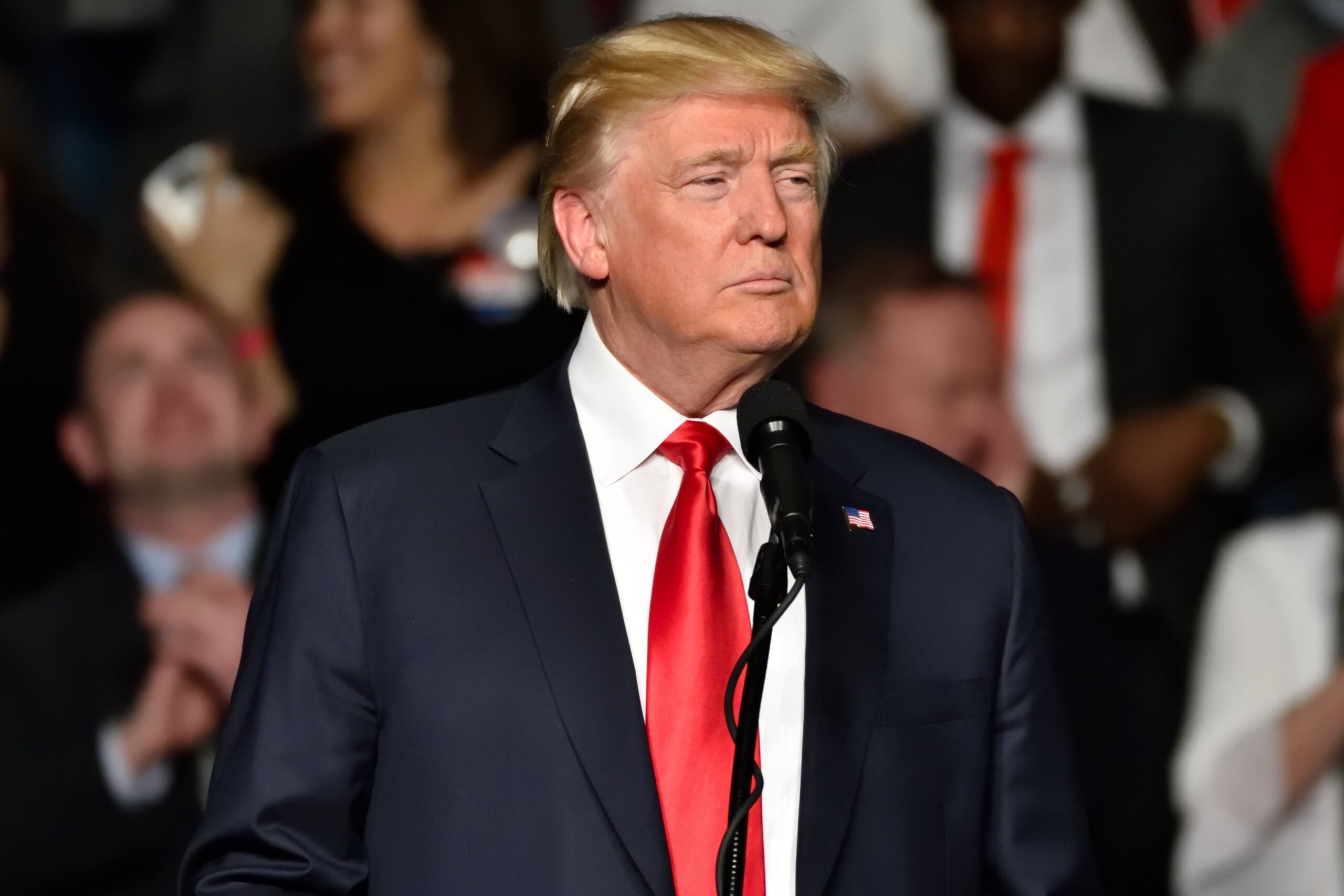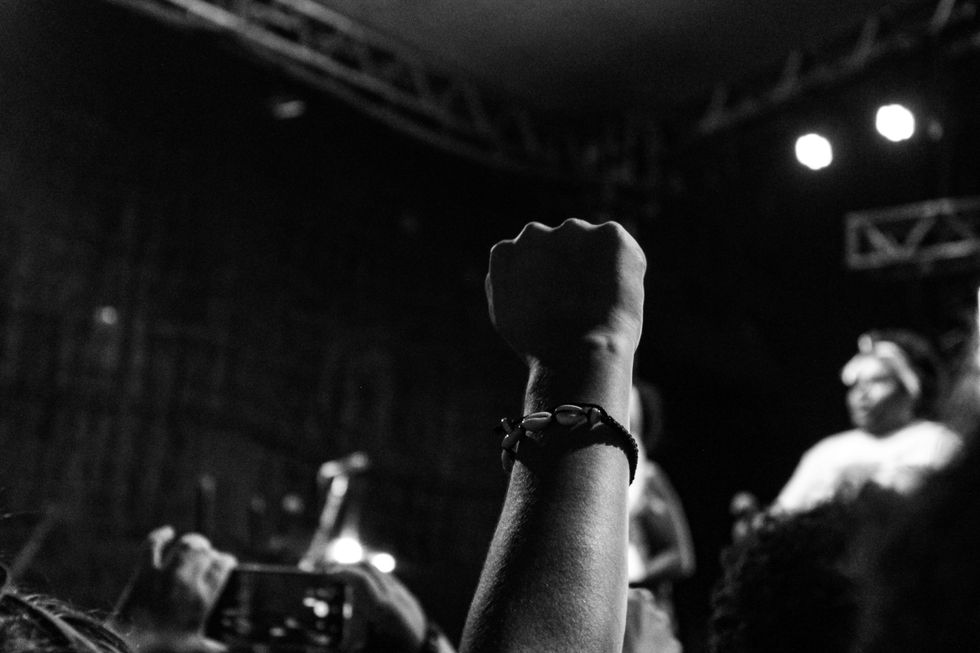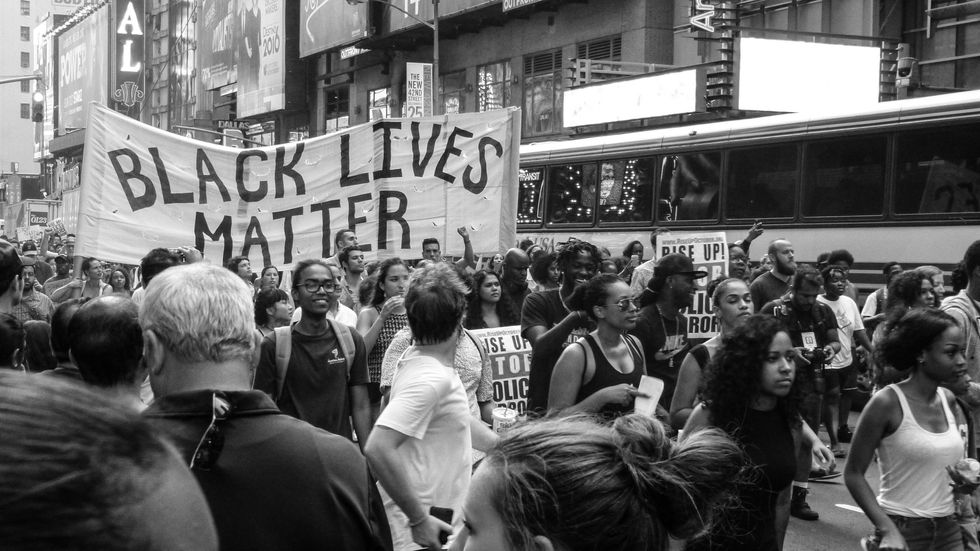
President-Elect Donald Trump makes a proud gesture during his speech at a "Thank You" Tour rally held at the Giant Center.
Photo by: Evan El-Amin/ Shutterstock
If you’ve watched Fox News recently, you have almost certainly heard the term “antifa” uttered with an air of sinister mystery and more than a hint of contempt, but what actually is it?
Antifa, pronounced “AN-tee-fuh,” is short for antifascists. Antifa is not an organization, as they have no leader, no hierarchy, and no regular meetings or gatherings. It is instead a left-wing political ideology that aims to eradicate fascism and white nationalism through the use of both nonviolent and violent direct action rather than policy reform. Essentially, they are a group characterized entirely by opposition to one thing: fascism.
Webster’s Dictionary defines fascism as “a political philosophy, movement, or regime that exalts a nation and often a race above the individual and that stands for a centralized autocratic government headed by a dictatorial leader, severe economic and social regimentation, and forcible suppression of opposition.” Most Americans agree that fascism is a bad thing. It’s regularly associated with bigotry and authoritarian dictators like Hitler. So why are we mad about anti-fascists? To understand that, we have to look at their history.
The History of antifa
The history of anti-fascism begins around the same time as the history of fascism. In 1932 Germany, a group called “Antifaschistische Aktion” formed in opposition to the rising Nazi party. It was a militant anti-fascist organization in the Weimar Republic started by members of the Communist Party of Germany (KPD), and it only existed from 1932 to 1933. Antifaschistische Aktion used their militant approach to develop a self-defense network for communities targeted by the Nazis. The group engaged in a series of direct actions meant to challenge the Nazis, including street brawls, but they were forcibly dissolved after Hitler’s rise to power.
Around the same time, the British Union of Fascists (BUF), a Nazi-like political party, was gaining political power in the UK. But when the BUF attempted to lead a march through London in 1936, thousands of Jews and left-wing activists attacked the fascists and their police escorts, raining homemade bombs and rocks down on the parade. The BUF forces retreated and the anti-fascists celebrated victory in “the Battle of Cable Street.” The event is still cited by antifa activists today.
The modern antifa movement finds its roots in London’s Anti-Fascist Action (AFA). Founded in the UK in 1985 by a wide range of anti-racist and anti-fascist organizations, the AFA was a militant anti-fascist group. It was active in fighting far-right organizations, particularly the National Front and British National Party. They were particularly active in the punk scene, where they would often violently throw neo-Nazis out of punk shows.
A similar organization called Anti-Racist Action (ARA), also connected to the punk music scene, formed in America in the 80’s. In the late 1980s and 1990s, ARA activists toured with popular punk rock bands in order to prevent white supremacists from recruiting at their shows. They would remove any neo-Nazi materials and forcibly remove anyone espousing neo-Nazi philosophies.
What does antifa look like today?

Antifa is not an organization; it’s an ideology, and as such, it is highly decentralized and localized. There are some specific local organizations, like Portland’s Rose City Antifa, which was founded in 2007, but there’s no national umbrella leadership or hierarchy. There is no uniform course of action for antifa, but they do tend to operate on one principle: Stopping fascism by any means necessary.
In The Antifascist Handbook, antifa historian Mark Bray writes, “The job of the anti-fascist is to make [fascists] too afraid to act publicly and to act as volunteer targets for their hate and attacks which might keep them from thinking about burning down the mosque in their neighborhood.”
In order to intimidate “fascists,” antifa uses a variety of tactics. Online, they use a technique called doxxing. They identify white supremacists and fascists and expose them online in an attempt to get them fired from their jobs and evicted from their apartments. Antifa also uses no-platforming or de-platforming, which involves denying fascists the opportunity to speak out in public by obstructing their events.
The tactic that makes most people nervous about antifa is their use of violence. Antifa generally seeks out fascists and racists and disrupts any-and-all rallies through violent confrontations. Antifa has been known to use sticks, fists, and projectiles, though they are almost never associated with guns.
In general, Antifa appears as counter-protesters, not protesters themselves. They look to events in history like the Battle of Cable Street, and claim that fascism can only be stopped by using violence. You can recognize antifa at a protest either from their logo—a red flag over a black flag—or sometimes from their use of black bloc strategy. The black bloc is where people dress in black and cover their faces in order to thwart surveillance and create a sense of equality among participants. Sometimes antifa members using this method try to operate as a “security force” for protesters.
Since Trump was elected in 2016, anti-fascist counter-protesters have become much more mainstream. Thousands of people protested at Donald Trump’s inauguration, including some self-proclaimed anti-fascists. Memorably, after the inauguration, white-supremacist Richard Spencer was punched in the face by a black-clad protestor—and after the incident went viral on social media, Richard Spencer blamed it on antifa.
A few months later in August 2017, Antifa counter-protesters showed up at the “Unite the Right” rally in Charlottesville, Virginia and violently clashed with alt-right protesters. During the rally a neo-Nazi plowed into a crowd of counter-protester, injuring dozens and killing one woman, Heather Heyer.
In March 2018, Richard Spencer canceled the remaining stops on his college speaking tour, releasing a tearful video in which he declared that “antifa is winning.”
Coverage of antifa has gone up significantly during the recent racial justice protests. This summer, between May 24th and August 22nd, ACLED recorded more than 10,600 protests in all 50 states and Washington, DC. Most of the protests were about police brutality, and around 10,130 of them were peaceful. However,the media has spent a lot of time on the approximately 570 protests that involved some form of violence. Donald Trump has repeatedly blamed the violence at protests on antifa, which has given the movement significant media attention.
Trump and his supporters have designated antifa as public enemy #1. He has mentioned antifa in 41 tweets and has credited antifa with all of the violence and looting of the Black Lives Matter protests, and even accused the 75-year-old man who was pushed over on camera by the police in Buffalo of being an “antifa provocateur.”
Trump also declared via Twitter that he would designate antifa as a terrorist organization, despite the fact that he legally cannot declare any domestic group as a terrorist organization. Overall, he has given antifa a lot of attention without presenting any actual evidence of antifa involvement.
Are antifa responsible for protest violence?

Any group that believes that the ends justify the means should be viewed as a threat. That being said, so far there is no evidence that the violence at the racial justice protests is caused by antifa or even that it has been coordinated at all. Thousands have been arrested at the protests, but most are for misdemeanor charges such as breaking curfew. The few more serious offenses, including murder and throwing molotov cocktails at police vehicles, have resulted in federal charges. According to the Washington Post, there are roughly 80 federal charges stemming from the protests, but thus far there are no mentions of antifa in any of the court documents. However, the far-right “boogaloo” movement is tied to 4 of the offenders.
Seth Jones, an expert on terrorism at the Center for Strategic and International Studies, writes, “My conversations with law enforcement and intelligence officials in multiple US cities suggest that [though] antifa played a minor role in violence, the vast majority of looting appeared to come from local opportunists with no affiliation and no political objectives. Most were common criminals.”
A May 31 memo from the FBI’s Washington field office reported “no intelligence indicating Antifa involvement/presence” in DC protests. The Associated Press analyzed court records, employment histories, social media posts and other sources of information concerning the 217 people arrested May 29-31 in Minneapolis and DC, and found that almost all were local residents, and very few had any connection to any extremist organizations.
Even the Department of Homeland Security admits that most of the violence seems to be caused by local “violent opportunists” rather than extremists, despite the fact that a recent whistleblower claimed that DHS officials were directed to play up the threat presented by antifa to match the president’s rhetoric.
Antifa has existed in some form in the United States since the 1980s, and they have never posed much of a domestic terror threat. The only known death caused by an antifa supporter happened a week ago, by a man who stated on Instagram that he was “100% antifa” but was not affiliated with any antifa group.
According to the Center for Strategic & International Studies (CSIS), between 1994 and 2020, there were 893 terrorist attacks and plots in the United States. Right-wing terrorist (Boogaloo, Sovereign Citizens, white supremacists, incels, etc.) attacks caused 335 deaths, while left-wing (extreme environmentalists, animal rights extremists, anti-capitalists, anarchists, etc.) attacks caused 22 deaths. Most importantly, antifa caused no known deaths.
Why Trump’s antifa rhetoric should scare you.
Antifa is not responsible for the level of violence Trump claims, but it is a real extremist ideology that does use violence as a tactic. This fact has led Trump and his supporters to use it as a catch-all term for leftists in order to scare people on the right.
This is concerning for a number of reasons, and is somewhat—dare I say it—fascist. A defining feature of fascism is forcible suppression of the opposition and Trump is trying to use antifa to do exactly that.
Antifa doesn’t have official membership, which gives Trump and his supporters a lot of leeway to dictate who is in “antifa” and who it isn’t. If antifa includes anyone who is against fascism, it would likely include most Americans.
Trump’s misapplication of the label “antifa” to include all left-leaning activists rather than limiting it to those who proactively seek physical confrontations has resulted in dangerous generalizations. He continues to paint a picture of this summer’s protesters as a monolithic leftist group who desire nothing more than chaos.
In reality, racial justice protesters are very diverse. According to Pew Research, 59% are over 30, 42% live in the suburbs, and 17% lean Republican. The protesters are people from every walk of life who genuinely feel that police brutality and racial injustice are serious problems.
As long as antifa is a shadowy, amorphous group, it will continue to be used as a punching bag for the right. The lack of information about antifa has already given rise to various conspiracy theories regarding it. Some claim it is being funded by George Soros, who is somehow also a Nazi. Some even claim that Soros is sending out buses marked “Soros riot Dance Squad” full of antifa members intending to start riots.
Others falsely claim that the Democratic party is funding antifa and hiring paid agitators. These claims are quite obviously false, yet they spread like wildfire. One of the most concerning disinformation campaigns about antifa in recent memory was the twitter account @antifa_us, which encouraged violence at protests. The account was removed by twitter after it turned out to be operated by Identity Evropa, a white supremacist group.
By playing up the scale of the antifa threat, Trump has made antifa seem just as bad, if not worse, than other extremist groups. However, the statistics show us that this is simply not the case.
The anti-defamation league warns that “it is important to reject attempts to claim equivalence between the antifa and the white supremacist groups they oppose.” They add that, “Right-wing extremists have been one of the largest and most consistent sources of domestic terror incidents in the United States for many years; they have murdered hundreds of people in this country over the last ten years alone. To date, there have not been any known antifa-related murders.”
Antifa is extreme, and we should all condemn their use of violence—however rare it may be. But perhaps their cause is a worthy one. After all, it does seem awfully fascist to declare anti-fascists terrorists.














